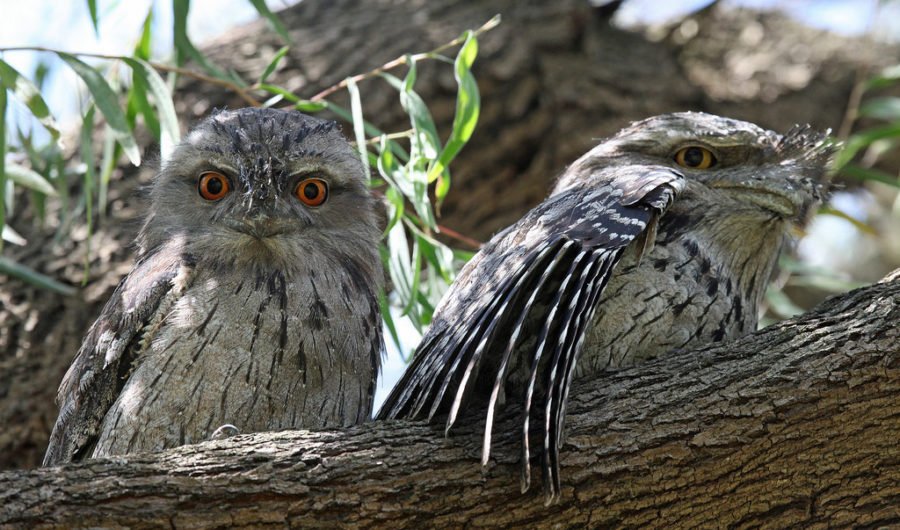Deadly stare: Australia’s iconic tawny frogmouths

KNOWN FOR THEIR shape-shifting abilities and deadly, or depending on the context, simply disinterested expressions, tawny frogmouths (Podargus strigoides) are Australia’s biggest characters.
Gisela Kaplan, Australia’s foremost expert on the tawny frogmouth has been studying these birds for over 25 years.
In 1993, she was given her first chance to see the tawny up-close after she joined WIRES and was given a nestling to hand-raise.
“I was fearful of whether or not I could actually raise this thing because I knew so little about it. I was completely thrown in the deep end but I started reading up on tawny frogmouths almost immediately.”
Prior to Gisela’s work on tawny frogmouths, little was known about these birds other than their flight patterns, which had been recorded by various bird watchers.
“I scanned every single journal from 1900 to the present day to find what was ever said or mentioned about tawny frogmouths. Often it would be just a single sentence so it was extremely laborious to get information and create an overall picture of these birds.”
Her research eventually culminated in a book focussed solely on the behaviour, habitats and social lives of tawny frogmouths, of which a revised version is due to be released next July.

(Image Credit: Wikimedia)
A master of disguise
Gisela says that one of the major reasons the tawny frogmouths are considered so endearing is because they seem unperturbed by the presence of humans. But she says this is simply a defence mechanism.
“It’s one of their most successful defence strategies. They just sit and pretend not to be there to avoid interaction.
“I’ve watched a group of magpies approach a tawny frogmouth and they looked at each other, looked at the tawny and then looked back at each other while they seem to be vocalising ‘What on earth is this?’
“They inspected the bird for a good ten minutes, then deemed it wasn’t a risk and they flew away.”
Such masters of disguise are the tawny frogmouths that they’re often mistaken for tree trunks or plants.
“When they’re nestlings, their downy feathers are so thick that they bear less the shape of a bird and appear more like a tripod.
“In the first week post hatching they have bright white plumage that makes them look almost exactly like eucalypt flowers with white spikes going in all directions.
“They tend to use trees that match their patterns so even when they’re just sitting there it’s quite difficult to spot them.
“They’ll also stretch their necks upwards so that their beaks form a line with their elongated neck making themselves look slimmer and taking the shape and appearance of a dead branch.”
According to Gisela, in addition to the camouflage mechanisms used by the birds, their ability to regulate their body temperature is of great interest to science.
“They’re the largest bird that has the ability to lower its own temperature to save energy. They have all these mechanisms for surviving in a very harsh continent. It’s uniquely adapted to the Australian environment.”
The ultimate death stare
On occasion, Gisela says she’s witnessed the bird get a little trickier with their defence mechanisms, choosing to open their eyes and surprise a predator that may have gotten a little too close for comfort.
“The funniest context I’ve ever seen this occur was in a veterinary hospital in Tamworth, which had three orphaned tawny frogmouth juveniles on a perch in the reception area where the youngsters roosted and slept through the day.
“People were coming in with cats and dogs but most people just thought the juveniles were toys because they sat totally still and didn’t budge once.
“At one point a Great Dane approached their perch sniffing, and one of the tawny frogmouths opened its eyes and stared at the Great Dane. This huge dog was so startled, it immediately jumped backwards.”

(Image Credit: Christopher Watson/Wikimedia)
Equality of the sexes
According to Gisela, one of the most interesting behaviours exhibited by the tawny frogmouths is the way they joint parent.
“The male seems to sit during the day and the female during the night, and they feed the chicks equally. They never leave their offspring on their own, even when they have fledged, usually squashing the youngsters between them when they roost.
“It’s one of the amazing strengths and successes of these birds.
“It’s not just mum bringing them up and having to leave them there’s always somebody guarding the nest and protecting the young.”
‘Tawny’ the tawny frogmouth
Over 20 years ago, Gisela rescued an orphaned tawny frogmouth and attempted to nurse it back to health, but the bird failed to recover its ability to recognise food and so has lived with her ever since.
Because of her intention to set the bird free she chose not to name it, but over time it’s become affectionately known as ‘Tawny.’
“He’s totally unique and he’s become quite famous. He’s been in the Sydney Morning Herald and the Age. He’s been all around Australia. He’s quite an ambassador for his species,” she says.
Gisela had travelled with ‘Tawny’ to primary schools across Australia, until concerns around bird disease prevented them from doing so.
“I’d take him out of a box for a brief time and they could all touch it and look at him up-close.
“It changed lives in the sense that some students set their eyes on studying biology or wanting to work with animals, and that’s through the exposure to just one tawny frogmouth.”
Gisela is hopeful that future generations will take an interest in these unique birds.
“Very little was once known about the tawny frogmouths. I would like to see every single bird in Australia captured with their personalities and their life style. Unfortunately, I’m going to run out of life span and there are generations of work to be done yet.”

(Image Credit: Max Pixel)

